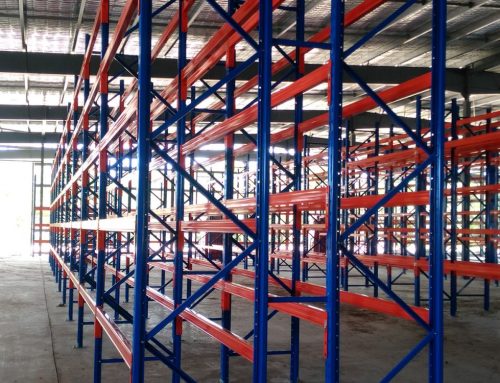Warehouse pallet racking requires a lot of planning!
Effective racking systems can boost profitability by saving time, space and a range of other business expenses.
Although racking requires ongoing maintenance the most important advice is to plan, plan and plan!
Do you want to begin on the right foot? Here are some pallet racking basics for your business:
Create a Master Plan
The backbone of an efficient racking system is a carefully crafted master plan. Spend most of your time determining your exact product storage needs. Are the products to be palletised or do they need to sit independently on shelving? Do you have unusual shaped products that require wider bays? Are your products long, thin and better suited to storage on a cantilever system? Do you have high turnover products better suited to a drive-in rack or gravity fed system? What warehouse equipment do you currently own and what will you need in the future?
Budget is obviously a key factor in planning. Try and establish the savings made in installing more efficient racking. When you subtract these savings over the life of your racking you may find the initial project capital expenditure diminishes significantly.
Ultimately, recognising the purpose of your product storage requirements will make life easier in the long run.
Study Your Warehouse Layout
After creating a master plan, take time to know the ins and outs of your warehouse layout. Your physical space/structure can either make or break your plan. Understand the (1) size, (2) shape, and (3) height of your warehouse. These three factors will also determine the type of racks you need and the designation of your pallet racking systems. Allot enough spaces for equipment turning circles, pathways, windows, entrances, exits and safety equipment. Achieving workflow productivity is the ‘holy grail’ of warehouse design .
Check Your Options
Even though you have a firm idea of your racking needs, it is advisable to check all the options available in the market. It is expected that you’ll encounter racking products from various companies claiming the superiority of their offer. In order to pick the best option look at the accessibility, versatility and robustness of the product. Look for dealers that offer a wide array of quality products and services at a competitive price. Most importantly, choose a supplier that can help you with repairs, additional product, audit support and other sales support in the years to come.
Know The ‘Racking Rules’
There are some basic rules to follow when you’re constructing your racking.
The ‘maneuver rule’ requires you to add 150mm between the top of your pallet loads and the bottom of the next beam. Reducing this clearance will result in limited ‘lift off’ and the potential to damage product and racking. Secondly, if you’re planning to have double pallet bays, add approximately 250mm – 300mm to the width of the pallets to determine your overall beam length. This gives ample space in between upright frames to move pallets on and off the shelves.
Also consider the ‘shock factor rule’. A shock factor provides a weight rating margin for when heavy products are placed on racking. So when beam levels are rated at 2,000Kgs., reduce your load about 25 percent to account for loading shock.
Lastly, take some time to read through the Australian standards on Steel Storage Racking AS4084-2012. Familiarising yourself with these rules and regulations will save yourself considerable headaches in the future. In addition, working with a reputable pallet racking specialist in Queensland, Australia, will make your pallet racking project easy, effective, and efficient.
[activecampaign form=1]




